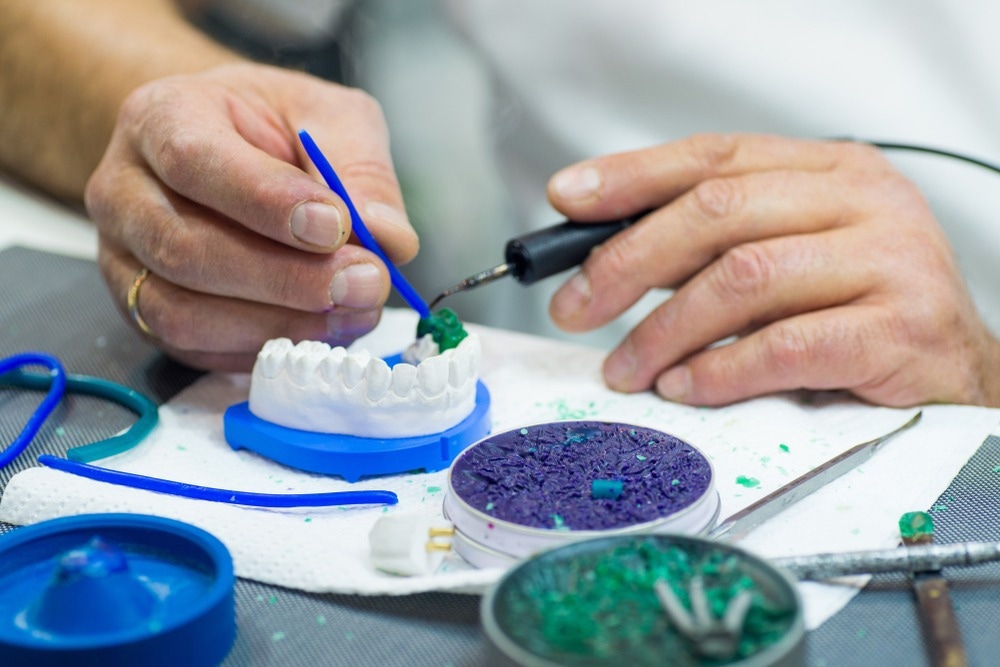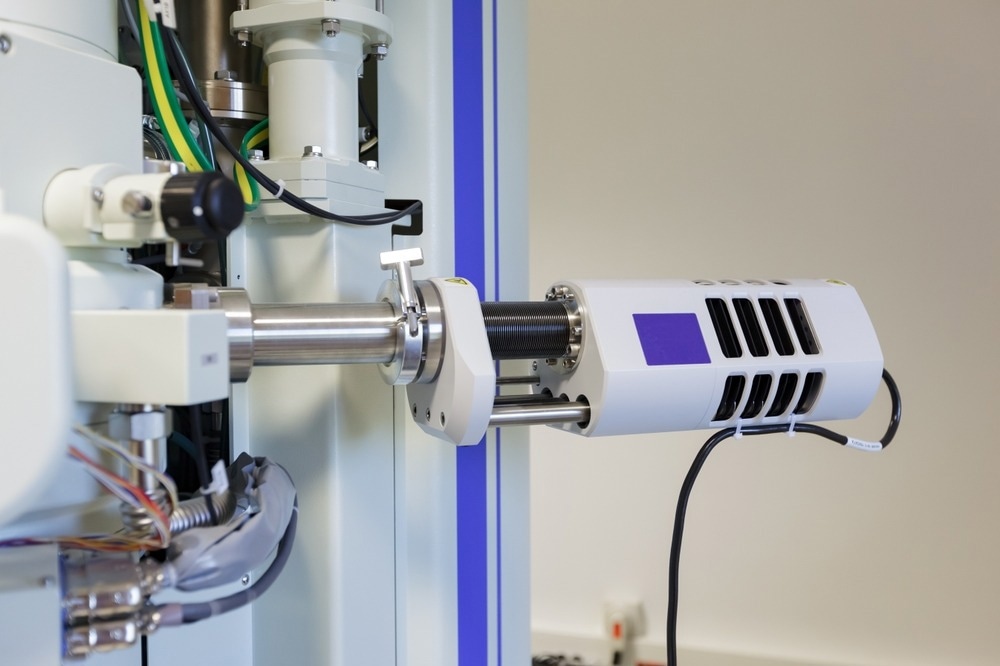The elemental analysis of dental materials is an important aspect of modern dentistry that helps to ensure the safety and effectiveness of various dental products. In this article, we will define what dental materials are, explore why their elemental analysis is important, what types of materials are typically analyzed, and some methods used to do the analyses.

Image Credit: Marko Rupena/Shutterstock.com
What are Dental Materials?
Dental materials are specially made materials that are used in dentistry for fillings, crowns, bridges, and orthodontic appliances. They can be made from natural tissues, metallic alloys, polymers, ceramics, or can be composites.
Some common examples of dental materials include dental amalgams, which are used as fillings in teeth; dental cement, which is used to bond crowns and bridges to teeth; orthodontic brackets, which are used to straighten teeth; and denture materials, which are used to create artificial teeth.
When used, these materials come into contact with the mouth and can be ingested or inhaled, making it essential to ensure that they are free from harmful contaminants and toxins.
Elemental Analysis of Dental Materials
The elemental analysis of dental materials is a vital aspect of modern dentistry that helps to ensure the safety and effectiveness of the materials used in various dental procedures. These analyses of dental materials have become increasingly necessary over the past few decades due to a growing concern over the safety and effectiveness of these products.
Reasons for Performing Elemental Analysis on Dental Materials
One important reason for performing elemental analysis on dental materials is to verify their composition and purity. Dental materials, such as fillings, crowns, and bridges, are often made from a variety of different elements and compounds. This can be especially important for materials that are used in medical implants or prosthetics, as they may be in contact with the body for an extended period of time.
Different materials have different properties and characteristics, and it is important to understand these properties to determine which materials are best suited for a particular application. For example, some materials may be more resistant to wear and tear, while others may be more resistant to heat or cold.
It is important to ensure that these materials are of high quality and free from contaminants that could potentially be harmful to patients. This enables dentists and dental laboratories to ensure that they are using materials that are safe and fit for their intended purpose.
Another reason for performing elemental analysis on dental materials is to assess their performance and durability. Different dental materials have different properties, such as strength, flexibility, and biocompatibility, which can influence their suitability for use in different situations. Through these analyses, dentists can better understand how they will perform in the mouth and how long they are likely to last.
In addition to these reasons, elemental analysis can also help to advance the field of dentistry by providing valuable insights into the properties and behavior of different dental materials. This knowledge can be used to develop new and improved dental materials that are safer, more effective, and more durable.
Methods Used to Perform Elemental Analysis of Dental Materials
The practice of elemental analysis of dental materials became more widespread in the 20th century as new technologies and techniques were developed to carry out these analyses. One of the first methods used was x-ray fluorescence (XRF), which was developed in the 1930s.
Several other methods can be used to perform elemental analysis on dental materials, including X-ray fluorescence (XRF), inductively coupled plasma mass spectrometry (ICP-MS), and energy-dispersive X-ray spectroscopy (EDS).
X-ray fluorescence (XRF) is a non-destructive analytical technique that utilizes x-rays to excite the atoms in a sample and measure the energy of the emitted photons. This technique is commonly used to analyze the elemental composition of dental materials, including metals, alloys, ceramics, and polymers.
XRF allows scientists to identify the presence and concentration of specific elements in a sample, helping to ensure that the material meets safety standards and is suitable for use in the mouth.
Inductively coupled plasma mass spectrometry (ICP-MS) is another widely used technique for the elemental analysis of dental materials. This technique involves vaporizing a sample of the material and analyzing the resulting ions to determine the elemental composition. ICP-MS is a highly sensitive and precise technique that can detect trace elements at very low concentrations, making it particularly useful for analyzing dental materials.

Image Credit: Pvince73/Shutterstock.com
Energy-dispersive X-ray spectroscopy (EDS) is a technique that uses X-rays to identify the elemental composition of a sample. This technique is commonly used to analyze dental materials, including metals, alloys, and ceramics. EDS allows scientists to determine the elemental composition of a material by measuring the energy of the emitted X-rays, which is unique to each element.
These techniques allow scientists and dentists to accurately identify and quantify the various elements present in a dental material, providing a detailed picture of its composition and properties.
For example, a study published in the Scientific Reports Journal investigated the beryllium content in 32 commonly used dental materials. Beryllium can cause a lung disease called chronic beryllium disease which can be fatal. The analysis was done with inductively coupled plasma-optical emission spectrometry and X-ray fluorescence spectroscopy. Beryllium traces in the materials were found to be below clinical relevance.
Conclusion
The elemental analysis of dental materials is an essential aspect of modern dentistry that helps to ensure the safety, effectiveness, and performance of the materials used in various dental procedures. By analyzing the elemental composition of dental materials, dentists and dental laboratories can make informed decisions about which materials to use and how to best use them, ultimately improving the quality of care patients are provided with.
More from AZoM: What are Semiconductor Pixel Detectors?
References and Further Reading
Borcic, J., Braut, A. (2012). Finite Element Analysis: New Trends and Developments. BoD – Books on Demand. https://openresearchlibrary.org/ext/api/media/561d3f0b-38c7-4d8e-980c-b99bce212a26/assets/external_content.pdf
Burkhardt, F., Pieralli, S., Bergfeldt, T., Wemken, G., Wesemann, C., Stolz, D., Spies, B.C. (2022). Elemental analysis of contemporary dental materials regarding potential beryllium content. Scientific Reports 12, 19119. https://doi.org/10.1038/s41598-022-21068-9
Chander, N.G., 2018. Characterization of dental materials. The Journal of Indian Prosthodontic Society 18, 289–290. https://doi.org/10.4103/jips.jips_292_18
Geng, J.-P., Tan, K.B.C., Liu, G.-R. (2001). Application of finite element analysis in implant dentistry: A review of the literature. The Journal of Prosthetic Dentistry 85, 585–598. https://doi.org/10.1067/mpr.2001.115251
Kaczmarek, K., Leniart, A., Lapinska, B., Skrzypek, S., Lukomska-Szymanska, M. (2021). Selected Spectroscopic Techniques for Surface Analysis of Dental Materials: A Narrative Review. Materials 14, 2624. https://doi.org/10.3390/ma14102624
Preoteasa, E.A., Preoteasa, E.S., Suciu, I., Bartok, R.N. (2018). Atomic and nuclear surface analysis methods for dental materials: A review. AIMS Materials Science 5, 781–844. https://doi.org/10.3934/matersci.2018.4.781
Disclaimer: The views expressed here are those of the author expressed in their private capacity and do not necessarily represent the views of AZoM.com Limited T/A AZoNetwork the owner and operator of this website. This disclaimer forms part of the Terms and conditions of use of this website.